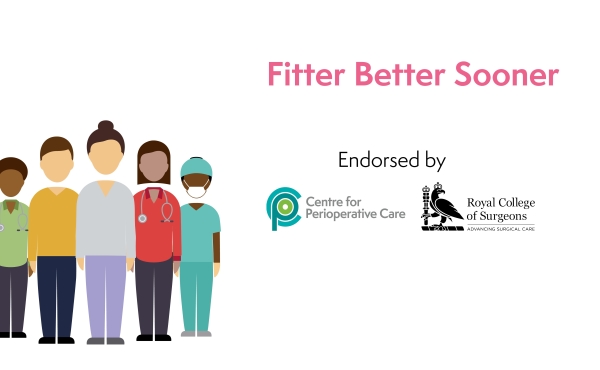Case Studies: Older People Undergoing Surgery
Pro-active Care for Older people undergoing Surgery (POPS)
Established in 2004,the POPs multidisciplinary team is led by a consultant geriatrician and engages with the patient throughout the surgical pathway, from preoperative assessment through the surgical admission to discharge to the community.
The POPS service has reduced postoperative complications and length of stay as evidenced in a published pre- and post study conducted in elective orthopaedic patients and is now being replicated across other units in the UK (e.g., Nottingham, Reading, Addenbrookes, Sheffield)
It is well recognised at a national level that frail, older and multimorbid patients suffer adverse outcomes after surgery. Models of care have been piloted in the UK in which perioperative geriatricians have been aligned with surgical services to focus on medical issues in the perioperative pathway. Such service developments have been proven to positively influence patient outcomes, reduce complications and length of stay.
In Bristol, we were well aware of these issues in patients undergoing vascular surgery. Perioperative mortality in abdominal aortic aneurysm repair was high in our centre and post-operative complications for complex vascular surgery problematic. There was an appetite amongst the surgical consultant body to pilot a new model of care. We aimed of improving patient outcomes for the approximately 800 patients aged >65 admitted under vascular surgery per annum.
Solutions
Following publication of a RCT trialling collaborative perioperative geriatric support for vascular surgery, the intervention (Geriatrician-led Perioperative Comprehensive Geriatric Assessment) was implemented into the patient pathway for frail, older or comorbid patients undergoing major vascular surgery.
The service was designed to embed perioperative geriatricians at various points throughout the surgical pathway. This was achieved in the preoperative setting to support patient selection and shared decision-making.
Post-operatively, programmed daily medical ward rounds were established to proactively address medical complications, review emergency vascular admissions and to facilitate rehabilitation and discharge planning.
The outcomes data revealed positive effects on length of stay (mean reduction 2.8 days) and complications (reduced by 56% in acute admissions). The service was progressively expanded to burns, colorectal and acute gastrointestinal surgery in 2018. Further successful outcomes and business-planned staff recruitment allowed expansion into Major Trauma in 2019.
The service currently employs the model of care piloted in vascular surgery for UGI, LGI, Burns, Plastics and Major Trauma surgery teams. Further expansion has been requested by urology, spinal and neurosurgery and is currently being business-planned.
Challenges
There has been widespread support for this model of care across divisions and specialties. Gaining the support of surgical, anaesthetic or nursing bodies has not been problematic.
Challenges have mainly focussed on obtaining sufficient time with medical job plans to deliver a service capable to improving perioperative clinical outcomes. This was achieved by persuasion of key stakeholders in medicine of the potential value of the service; this secured allocation of clinical DCCs to establish and expand the service from the initial pilot area in vascular surgery to other surgical specialties.
Further development of manpower to deliver and evidence-base the service was achieved by reallocation of existing resource. Existing junior doctors were supported in collecting data to evaluate the impact and tutored in the principles of service development.
The pilot-site in vascular surgery was selected to ensure the ambitions of the pilot-project could be reasonably achieved with the resource initially available. Positive outcomes data have subsequently permitted staged expansion into other surgical specialities (by request) with 4 medical consultants now carrying perioperative DCCs and 2.6 full-time perioperative clinical fellows (from physician-specialty backgrounds) supporting the service. The potential roles of ANPs and Physician Associates are currently being evaluated.
MDT Working
One of the main aims of this service development was to provide support to consultant surgeons and anaesthetists with challenging decision-making. This was reported by clinicians to be a real clinical challenge, especially when they were unclear whether the risk-benefit profile in high-risk patients supported surgical intervention. Our work in establishing a 3rd preoperative opinion adds a medical dimension, and provides evidence –based opinion on frailty, life-expectancy, medical comorbidity and surgical risk to support shared decision making. This is at the heart of modern multidisciplinary working.
Additionally, a daily presence on the vascular ward by physicians has provided open access support for junior surgical doctors who previously struggled to obtain help from the hard-pressed duty emergency medical team. Furthermore, integration into the vascular team has developed relationships with nurses and AHPs in the vascular service, and provided continuity and trust between medical and vascular teams. Whilst medical commitments currently leave room for further improvement in multidisciplinary working, the expansion of the service and building of a larger perioperative team means that resource to work throughout the patient pathway and take a bigger role in discharge planning is on the horizon.
Patient Outcomes
GIRFT data for the vascular service indicate that the Trust has exemplary nationally bench-marked mortality rates for EVAR and that major amputation rates are falling substantially. Whilst we cannot claim to be fully responsible for all improvements conducted across the regional network, our work has focused specifically on high risk surgery and aggressive management of medical complications in the highest risk patients.
Specific before & after analysis conducted as part of the service development has revealed the greatest reductions in length of stay (LOS) for ‘stranded’ vascular patients staying over 7 days. These are patients who have faced medical post-operative complications and major functional decline. Although overall length of stay fell by 2.8 days in all vascular patients aged >65 after implementation of embedded medical liaison, in stranded patients we have seen a greater mean reduction in LOS by 7.8 days (P<0.05). This may be explained by the reduction in medical complications by 56% (P<0.05).
These data reflect substantially improved care for the most vulnerable patients at highest risk of perioperative adverse outcome. Although mortality has not been shown to have fallen in vascular surgery, in emergency laparotomy, similar service evaluation shows that 30-day mortality fell by 74% (p=0.03) following implementation of daily physician support for acute surgical services.
Health Economics
The statistically significant reductions in length of stay that we have seen translate into improved patient flow. Bed modelling conducted by divisional manager’s estimates that our service development translates into 1500-3000 bed days saved per annum in the trust; this is equivalent to 5-10 additional surgical beds per year. The increased patient flow through the bed base is likely to improve turnover for elective surgical work, which in itself is an economic driver for the Trust through improved surgical income.
Furthermore, since April 2019 the new Best Practice Tariff for Major Trauma has rewarded trusts for frailty assessment in patients aged over 65. We have incorporated Major Trauma liaison into the perioperative service and in doing so, ensured that all patients are reviewed and frailty scored in accordance with BPT requirements. This is projected to generate >£830,000 in the financial year, and could not be achieved without physicians embedded into surgical services.
Additionally, we have evaluated the advantages of subjecting frail older patients to comprehensive geriatric assessment throughout their admission. This process generates active problem lists, and requires formal documentation of secondary diagnoses and defined complications. This approach has generated an additional £740 per patient reviewed by physicians. This figures extrapolates to >£380,000 of additional income for the numbers of patients seen in vascular surgery over a calendar year. It has also proven to be a strong financial driver indicating the economic value of our service development.
Feedback
Patient feedback has been supportive. We are currently working on how to robustly and scientifically evaluate the concepts of shared decision making and show that this has been improved.
Wider NHS/Government Practice
This service development is naturally aligned with various facets of the NHS Long Term Plan for England.
In the pre-operative setting, high risk patients receive a detailed, personalized risk assessment allowing better appreciation of the potential risks and benefits of surgery. This allows them to explore their options more carefully and provides less time-pressured forum for considered discussion. Patients (and their relatives) are honestly presented with their options and provided with bespoke, personalized perioperative management plans to identify the various perioperative issues than we can anticipate through pre-operative comprehensive geriatric assessment.
Proactive and pre-emptive management of medical problems leads to better support throughout a safer surgical journey, and properly joined-up care at delivered at the right time by the right people with the right expertise.
The results of this work show that comprehensive holistic assessment of our patients throughout the surgical pathway improves the accuracy of clinical coding and this means that our NHS Trust is fairly reimbursed for the work it undertakes. We have also showed improved in complications and inpatient length of stay (without increasing readmissions) which also reduces the overall costs of healthcare. These are examples of ensuring that taxpayers’ investment is used to maximum effect and that financial investment in the service is sustainable. These are important components of the NHS long Term Plan for England, but are equally applicable and relevant to the devolved nations.
Learning
The associated outcomes of this service development work have included reductions in length of stay, perioperative complications and mortality.
These data have been presented locally, regionally, nationally and internationally at various meetings and conferences. Academic publications describing to process and results are currently in peer review with anticipated publication in 2020.




